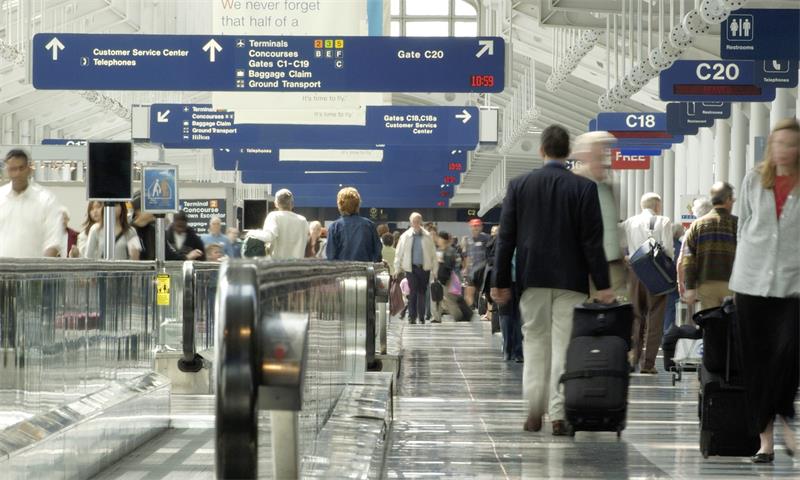Contents
Introduction
Airports can be a daunting and stressful place, especially for those who are not frequent flyers. However, knowing how to navigate airports like a pro can save you time, money and hassle in the long run. Whether you’re traveling for business or pleasure, having the knowledge to navigate airports smoothly will make your journey more enjoyable.
Importance of Knowing How to Navigate Airports
Knowing how to navigate airports is essential for anyone who travels frequently. It allows you to get through security and customs quickly and efficiently, reducing the likelihood of stress and delays during your journey. By being familiar with airport procedures, you’ll also be able to plan ahead and avoid common issues like missed flights or lost baggage.
Furthermore, understanding airport layouts and signage is crucial for finding your way around an unfamiliar space. This knowledge can help reduce anxiety in new environments by providing a sense of control over your surroundings.
The Benefits of Being a Pro at Navigating Airports
Being confident in navigating airports makes travel more enjoyable overall. You’ll have more time to relax before your flight instead of rushing around frantically trying to find the right gate or where to check in your luggage.
In addition, being familiar with airport procedures means that you’re less likely to encounter issues while traveling. For example, if there’s a flight delay or cancellation, knowing how the airline operates can help you reschedule or find another flight quickly without adding stress to an already frustrating situation.
The skills required for navigating airports may seem small but they are essential components that make up successful air travel experiences. In this article, we’ll explore some great tips on how best to navigate airports like a pro so that no matter where life takes us we always have full control over our travels!
Before You Go
Planning Your Trip in Advance
Traveling can be a lot of fun, but it’s important to plan ahead and be organized. First things first, figure out where you’re going and when you want to leave.
Look up the weather forecast for your destination so you can pack accordingly. Make a list of all the things you need to bring with you and check them off as you go.
Remember to include any medications or important documents, like passports or visas. Once you have a general idea of your itinerary, start looking for flights and accommodations.
Try to book your flights at least a couple of months in advance if possible – this way you’ll have more options and better prices. And don’t forget to check out different airlines – some may have better deals than others.
Packing Smartly and Efficiently
Packing can be one of the most stressful parts of traveling – but it doesn’t have to be! The key is to pack smartly and efficiently. Start by choosing a suitcase that’s the right size for your needs – not too big, not too small.
Then make sure all your clothes are clean and folded neatly before packing them. When it comes to packing clothes, try rolling them instead of folding them – this saves space in your suitcase and helps prevent wrinkles.
You can also use compression bags or packing cubes to keep everything organized. Don’t forget about toiletries!
Put all liquids in travel-sized containers (less than 3 ounces) so they meet TSA regulations. And remember that many hotels provide basic toiletries like shampoo and conditioner, so don’t worry about bringing these items unless you have specific preferences.
Checking in Online
Checking in online is a great way to save time at the airport. Most airlines allow travelers to check in up to 24 hours before their flight, and some even offer mobile boarding passes – which means you can skip the check-in line altogether! To check-in online, simply go to your airline’s website and enter your reservation information.
You’ll be able to choose your seat, print out your boarding pass (if necessary), and even pay for any checked baggage fees. It’s important to double-check all the information before hitting “submit” – mistakes can delay your boarding process or even cause you to miss your flight.
Overall, planning ahead and being organized are key when it comes to traveling. By packing smartly, checking in online, and having all your important documents in order, you’ll be well on your way to navigating airports like a pro!
Getting to the Airport
Choosing the Best Mode of Transportation
When it comes to getting to the airport, there are several modes of transportation you can choose from. Each option has its pros and cons, so it’s important to choose the one that works best for you. Firstly, if you have a lot of luggage or are traveling with a group, taking a taxi or ride-sharing service may be your best bet.
While this option can be more expensive than other modes of transportation, it allows you to arrive at the airport with ease without having to worry about parking or lugging bags around. Another great option is public transportation such as trains or buses.
This is a more cost-effective option and can be very convenient depending on where you live and what time your flight departs. Another thing to consider when choosing your mode of transportation is how close you are to the airport.
If you live far from the airport, driving yourself may not be feasible due to parking costs and long-term parking options may not be available at all airports. Ultimately, it is up to your personal preference and budget on which mode of transportation works best for you.
Arriving Early To Avoid Stress And Delays
It’s always better to arrive at the airport too early rather than too late; nothing adds to stress like trying not to miss a flight! Aim for arriving two hours before domestic flights or three hours for international flights; this will give you enough time for check-in and security checkpoints.
One way is ensuring that your mode of transport arrives earlier than necessary allowing adequate time in case there are unexpected delays along the way such as traffic jams. Most airports also offer suggestions on when passengers should arrive before their flights – check airline websites beforehand.
Remember that if something does go wrong – like long queues in security – running through an airport only adds unnecessary stress; keep calm and follow airport and airline officials’ instructions. Above all, give yourself plenty of time to get to the airport, so you can sit back, relax and wait for your flight without any last-minute rushes or panic.
At the Airport
Knowing Your Way Around
Navigating through an airport can be intimidating, especially if it’s your first time. But don’t worry, becoming familiar with the airport layout can make a big difference in reducing your stress levels.
Most airports have maps that are available online or at information desks throughout the airport. These maps will help you find things like gate numbers, restrooms, and food options.
If you’re not sure where to go, don’t hesitate to ask one of the friendly airport staff members for help. Another tip is to pay attention to the signs and directional arrows posted throughout the airport.
They usually come with icons and colors that will guide you to different areas of the terminal. For example, green signs often indicate exits or baggage claim areas while blue signs usually guide passengers towards gates and other important services.
Understanding Airport Signage
Airport signage can be confusing sometimes because of its unique language conventions. Understanding these conventions is essential in navigating airports like a pro.
One of the most common examples is reading flight boards that list departure times and gate numbers. Don’t panic if you see a code rather than your airline’s name on these boards – they’re just abbreviations for different destinations.
Another important sign to know is TSA security checkpoint signs, which are usually marked by large banners or illuminated displays overhead. It’s important to arrive here early because there may be long lines depending on how busy the airport is at that time of day.
Navigating Security Checkpoints
Security checkpoints can be frustrating for many travelers but following some simple tips can make things easier for you: – Make sure liquids are in containers no larger than 100 milliliters – Remove shoes and jackets
– Put all electronics into their own bins – Keep passports and boarding passes close by
Once through security, take some time to relax and unwind before your flight. You’re now one step closer to your destination!
Boarding Your Flight
Understanding Boarding Procedures
Knowing the boarding procedure of your airline can save you time and reduce stress. Airlines have different procedures for boarding, but they usually follow a similar plan. The boarding process typically starts with pre-boarding, which is when passengers requiring special assistance or those with young children are allowed to board first.
This is followed by priority boarding for members of frequent flyer programs, and first-class, and business-class passengers. General boarding occurs when passengers board according to their assigned seats.
Knowing When and Where to Board
It’s essential to know when and where your flight will be boarded so that you do not miss it. Most airlines will indicate the gate number and departure time on your boarding pass or through text/email notifications. Once you arrive at the gate, pay attention to announcements regarding boarding times and any last-minute changes to avoid confusion.
If you’re unsure about when to board, ask an airline representative for help. Don’t be afraid of asking questions; it’s better to be safe than sorry.
Being Prepared for Takeoff
Before takeoff, ensure that you have all necessary items within reach such as headphones, books/magazines or other items that will help pass the time during the flight. Make sure your seatbelt is securely fastened before takeoff and that all electronic devices are switched off or in airplane mode. If it is your first time flying or if you’re a nervous flyer, remind yourself that taking off is just like being in a car accelerating down a highway – only smoother!
If turbulence makes you anxious during the flight, try closing your eyes and taking deep breaths while relaxing your muscles one by one. By following these steps during boarding procedures before take-off can make all the difference in ensuring a smooth journey!
Layovers and Connecting Flights
Making the Most of Your Layover Time
Layovers can be seen as a hindrance to your trip but they can be turned into an opportunity to explore a new location and break up longer flights. When you have a long layover, plan ahead by researching the airport or nearby attractions. Some airports have free city tours for passengers with long layovers or offer free shuttles to nearby tourist spots.
Check with your airline or airport about these services. If you decide not to leave the airport, there are still many things you can do during your layover.
Most airports have restaurants, shops, lounges, and even spas that offer massages and other relaxing treatments. If you need a place to rest, some airports have sleeping pods or quiet rooms where you can relax in peace.
Take advantage of technology! Mobile apps such as GateGuru or FLIO provide maps of the airport terminals and gate information, which will help you navigate the airport more quickly and efficiently.
Navigating Connecting Flights Efficiently
Connecting flights can be stressful if not planned properly. Before booking your flight, make sure that there is enough time between connecting flights.
You should also try to book connecting flights on the same airline if possible; this will reduce the risk of delays due to unforeseen circumstances. When you arrive at your connecting airport, check departure boards for updated information on your connecting flight’s gate number and departure time.
If it has changed from what is indicated on your ticket stub or boarding pass, make sure to find out where the new gate is located before heading there. If time permits during your connection window and if it’s necessary for security measures in certain countries like the U.S., go through security again before boarding for connecting flight even though it may eat up some valuable minutes – this way you won’t risk missing your flight due to a long line in security.
Navigating connecting flights doesn’t have to be stressful. With a little bit of planning and careful attention, you can make the process smooth and painless.
After Your Flight
Collecting Baggage Smoothly
After a long flight, the last thing you want is to spend an eternity waiting for your baggage. To make sure you can collect your bags quickly and efficiently, there are several things you can do.
Firstly, check the baggage carousel number when you arrive at the airport, so you can head straight there after leaving your flight. Use luggage tags that stand out and are easy to spot amongst all the other bags.
This will make it easier to identify them quickly. Another useful tip is to pack light.
Most airlines allow one or two pieces of checked baggage per passenger, but if you only have one suitcase or bag with you, it will be much quicker and easier to collect it from the carousel. If possible, choose a suitcase that is easy to maneuver and has wheels.
Exiting the Airport with Ease
Getting through an airport after a long flight can be tiring and stressful, but there are several ways in which you can exit the airport with ease. Firstly, make sure that any important documents such as passports or visas are easily accessible in your carry-on bag before leaving the plane.
If you’re traveling internationally, customs may take some time so be prepared for this before arriving at passport control by filling out any necessary forms while on board your flight. Once through passport control keep in mind where ground transportation options like taxis or buses are located.
If someone is picking you up from the airport, confirm their location ahead of time so that they know where they should wait for you outside of arrivals. Some airports even have designated pick-up areas which will help speed up this process.
Tips for a Stress-Free Experience
To make sure your exit from an airport goes smoothly and stress-free as possible here are some tips: – Check any transport schedules ahead of time if you plan to take public transportation like trains or buses. That can give you an estimated time of arrival at your destination so that you can avoid any long waiting times.
– If you’re staying in a hotel, research the best options for transport from the airport to your hotel ahead of time. Some hotels offer free shuttles from the airport, which is a good way to save money and avoid transportation hassles.
– Finally, take a deep breath and relax! You’ve made it through the airport experience and now it’s time to enjoy your travels.
Additional Tips and Tricks for Navigating Airports Like a Pro
Staying Organized with Important Documents
When it comes to navigating airports like a pro, staying organized is key. One of the most important things you can do to make your airport experience smoother is to keep all of your important documents in one place.
This includes your passport, boarding pass, ID, travel itinerary, and any other essential paperwork. To keep all of these items in order, consider investing in a travel wallet or organizer.
This will allow you to keep everything together in one place so you won’t have to worry about fumbling through your bag at the airport. Additionally, make sure you have digital copies of all your important documents saved on your phone or tablet just in case.
Utilizing Technology
In today’s digital age, there are plenty of tools and apps available to help make navigating airports easier than ever before. Take advantage of these resources by downloading relevant apps onto your smartphone or tablet before heading out on your trip.
One must-have app is a flight tracking app that enables you to monitor real-time updates on your flight status and any delays or cancellations. Another useful app is an airport map app that provides information about each terminal and gate layout so that you can find amenities such as restaurants or lounges with ease.
If you’re someone who struggles with directions or gets lost easily, it may be helpful to download an augmented reality navigation app. These apps use augmented reality technology to provide step-by-step directions right on top of what’s around so that it feels as if the instructions are projected into real life.
Keeping Yourself Entertained During Long Waits
Let’s face it: Long waits at airports can be incredibly boring and frustrating. But there are plenty of ways to entertain yourself while waiting for departure time.
First, consider bringing a good book or e-reader to pass the time. Alternatively, you could download movies or TV shows onto your smartphone or tablet to watch during long flights.
If you’re looking for something more interactive, bring along a deck of cards or even a travel board game. This is also a great way to meet new people and make some travel buddies.
Many airports have lounges that offer amenities like comfortable seating areas, free Wi-Fi, and even showers. If you have access to one of these lounges, take advantage of it and make yourself at home while you wait for your flight.
Conclusion
Recap of Key Points to Navigate Airports Like a Pro
To navigate airports like a pro, you need to plan in advance, pack smartly, and check in online. Choosing the best mode of transportation and arriving early is also crucial. Knowing your way around the airport, understanding airport signage, and navigating security checkpoints are key factors.
Understanding boarding procedures and knowing when and where to board can make a difference. Making the most of your layover time and navigating connecting flights efficiently can save you time. Encouragement to Become an Airport Pro
Navigating airports like a pro isn’t as daunting as it may seem at first. With these tips, you’ll be able to go through the airport with ease even if you’re an infrequent traveler or not familiar with the airport layout.
By becoming an airport pro, traveling can be more enjoyable instead of a stressful experience. It’s always better to have more knowledge than less when it comes to traveling. An Optimistic Spin on Navigating Airports Like a Pro
Traveling is one of life’s great pleasures but getting there isn’t always easy or stress-free. However, with these tips on navigating airports like a pro at your fingertips, hopefully going through airports will be less stressful for you in the future so that you can focus on enjoying your journey even more! Remember that being prepared is key in everything we do in life including traveling; therefore don’t forget any important documents such as passports or boarding passes when heading out for an adventure!













